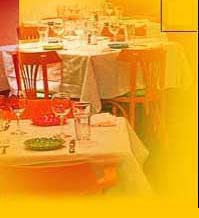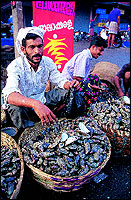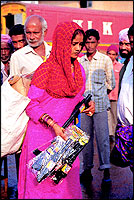


|
|
|
A LITTLE distance from the Malayam vegetable market on M. M. Ali Road in Calicut, is the city�s fish market. It is quite a Moplah domain. The fishermen are Moplahs, they wear the white turban of their Arab cultured race, or just a small hand towel wrapped around their heads. Some more enterprising than the rest wear plastic rain hats or improvised head gear made out of straw and tyre rubber. That has got nothing to do with culture and tradition. These fishermen are just particular about not getting smelly fish water onto their hair!
Buyers come and bravely hold up the Seer by its tail, weighing the fish and studying it from close before deciding on the purchase. It is rare that anybody buys the entire fish, but fillets, yes. The Mackerel is another popular fish on the Moplah menu. It is also easily available off the Calicut coast and lends itself suitably to recipes like the Meen Charu or Meen Mulakittathu. Which are variations of the classic fish curry, one being more chilli-hot than the other. In a roofed-in area, the actual selling is done over bloody tiled platforms. Jostling for space alongside the Seer, are baby Shark and Hammerhead Shark, their skin rough like sandpaper next to the smooth, oily body of the Seer.
The fishermen tell of having slipped out in the dark in slim catamarans to catch the currents before sailing out for miles to return with whatever is on sale at the market. There are of course deep sea trawlers that come into Calicut harbour with their catch and auction it off at the port itself later in the day. Fish is a treated with the reverence of meat on the Moplah menu in Calicut. It is given preference over chicken. Which is why you will find that one of the most popular dishes in this unique cuisine of Malabari Muslims is the biryani. Not mutton and chicken as much as Fish Biryani and Prawn Biryani!
|

Home Page
About the mag
Subscribe
Advertise
Contact Us

 The Moplahs' 'Meen' Market
The Moplahs' 'Meen' Market
 Almost everybody is dressed in a lungi and is wearing rubber Bata Hawaiiain slippers. It is the best footwear for the wet, slick and slushy market place. Pick your way gingerly, for there is much hustle and bustle about the place, and young men run about with great agility carrying heavy baskets of fish dripping water and ice. This is no place for women, though occasionally, one or two venture in to hawk breakfast foods or other commodities, but never to shop for fish. That is the man�s business in Calicut.
Almost everybody is dressed in a lungi and is wearing rubber Bata Hawaiiain slippers. It is the best footwear for the wet, slick and slushy market place. Pick your way gingerly, for there is much hustle and bustle about the place, and young men run about with great agility carrying heavy baskets of fish dripping water and ice. This is no place for women, though occasionally, one or two venture in to hawk breakfast foods or other commodities, but never to shop for fish. That is the man�s business in Calicut. In the distance, beyond the trucks that are unloading the day�s catch for sale in the market and over the tops of the seafood contractors� air-conditioned vans come to take away the prize of this catch, peeps the minarets of a modern-day Moplah mosque. However, this is not the time for namaz. It is the time for all good shoppers to come to the Malayam market and pick up what will decide the menu for their home that day. The devout among the Moplah fishermen, however, have already been to the mosque. They will go again in the afternoon.
In the distance, beyond the trucks that are unloading the day�s catch for sale in the market and over the tops of the seafood contractors� air-conditioned vans come to take away the prize of this catch, peeps the minarets of a modern-day Moplah mosque. However, this is not the time for namaz. It is the time for all good shoppers to come to the Malayam market and pick up what will decide the menu for their home that day. The devout among the Moplah fishermen, however, have already been to the mosque. They will go again in the afternoon. Inside the market, the Seer is the king of the Calicut fish scene, it is the Moplah�s favourite fish, and easily available in the warm waters off the vast coastline. The Moplahs favour the Seer because it offers them huge, chunky pieces of flesh and is almost meaty in its tastes and texture.
Inside the market, the Seer is the king of the Calicut fish scene, it is the Moplah�s favourite fish, and easily available in the warm waters off the vast coastline. The Moplahs favour the Seer because it offers them huge, chunky pieces of flesh and is almost meaty in its tastes and texture.  But there is also the Pomfret, and Prawns, everybody loves Prawns in Calicut. And Mussels. Fishermen sit with baskets alive with Mussels still muddy from the sea. This is a great
delicacy in Calicut. The meat is scooped out of the shell, marinated, stuffed back and cooked. Sometimes, entire baskets of Mussels are auctioned at the fish market.
But there is also the Pomfret, and Prawns, everybody loves Prawns in Calicut. And Mussels. Fishermen sit with baskets alive with Mussels still muddy from the sea. This is a great
delicacy in Calicut. The meat is scooped out of the shell, marinated, stuffed back and cooked. Sometimes, entire baskets of Mussels are auctioned at the fish market.